WE LIVE IN A NOISY WORLD
The Middle East has experienced rapid urbanisation and development and one of the major challenges brought by urbanisation is noise pollution. The increased urban activity has significantly contributed to higher noise levels in cities. This has become a significant concern, as it negatively impacts the quality of life for residents.
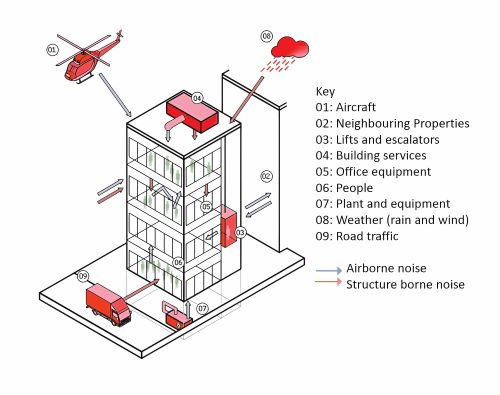
Exposure to high noise levels can have varying negative effects on individuals. Some may experience increased stress, difficulty in concentrating, and disrupted sleep patterns. Others may develop long-term health issues such as hearing loss and cardiovascular problems. The impact of noise pollution on individuals depends on factors such as their sensitivity to noise and the duration and type of exposure.
The building envelope plays a crucial role in defining the visual identity of a structure, addressing the thermal requirements of the environment, and providing a fire barrier for the safety of occupants. Additionally, an often-overlooked function of the building envelope is its ability to mitigate airborne noise.
Poorly designed buildings, or those that underestimate the importance of acoustic considerations in the building envelope, can have an adverse effect on the value of the entire property (for example, people do not want to stay in noisy hotels or live in a noisy apartment).
It is therefore imperative to recognise the significance of incorporating effective noise mitigation strategies into the early design and construction of buildings.
FACTORS INFLUENCING FAÇADE ACOUSTIC ENGINEERING
The following factors are key to the acoustic façade design:
- Location and surroundings: The geographical location of a building determines the noise levels it will be exposed to. Factors such as proximity to highways, airports, building services equipment, industrial areas, etc. can significantly impact the façade acoustic design. Figure 1 shows examples of noise sources that affect the acoustic design.
- Building function: The intended use of the building will determine the acoustic requirements. As an example, a concert hall has different acoustic requirements than an office building.
- Architectural design: The shape, size, and materials used in the construction of the façade will affect sound transmission and reflection. Elements such as windows, seals, frames, doors, walls and ventilation systems must be carefully considered.
- Regulations and standards: Requirements laid out in local regulations and standards will have an effect on the acoustic design of the façade.
FAÇADE ACOUSTIC DESIGN STANDARDS AND CODES IN UAE
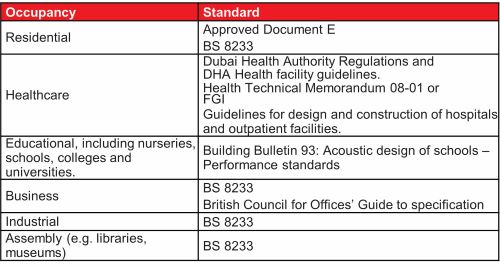
To address the noise issues, UAE has adopted acoustic standards and codes to help provide a quieter and more comfortable environment for its residents. The Dubai Building Code (DBC) has been in place since December 2021, replacing the previous Green Building Regulations and Specifications (GBR&S). Details of the new code can be found in the table below.
As a general rule, the sound insulation of the envelope, internal floors and partitions shall meet the minimum provisions of the reference standards listed in Table 1 in the Dubai Building Code (DBC-H.10.3, Page 632/843).
The UAE follows the UK Approved Document E for residential acoustic requirements. The document primarily focuses on internal wall separations between dwellings.
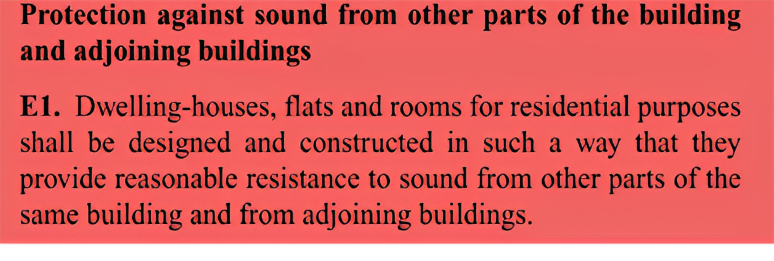
In addition to the above documents, BS 8233:2014 Guidance on Sound Insulation and Noise Reduction for Buildings also provides relevant acoustic information.
The World Health Organisation (WHO) provides recommendations on maximum indoor ambient noise levels in occupied spaces to provide an ideal level of acoustic comfort in commercial premises and suitable sleeping and resting conditions for residential dwellings.
Other references for noise intrusion mentioned in DBC 2021 are related to British Standards. This includes Health Technical Memorandum 08 – 01 (for healthcare), Building Bulletin 93 (for schools), and British Council for Offices, Guide to Specification (for offices).
As a final point, end-clients, hotel operators etc. may have additional specific requirements for their projects that also must be complied with.
TYPICAL BUILDING FAÇADE ACOUSTIC PROBLEMS
Acoustic considerations are frequently ignored in the building façade design, even when developments are situated near significant noise sources such as express highways, metro lines, airports, entertainment amenities, & outdoor MEP plant areas.
The following are examples of improper design leading to unwanted sound and poor indoor acoustic environments:
- Selection of improper glazing and/or frame type;
- Incorrect specification of openable façades (windows, doors);
- Poorly designed structural and architectural connection details such as transom and mullion configurations;
- Cheap quality façades and materials;
- Ventilation openings left untreated;
- Poor workmanship
THE FIRST STEP FOR ACOUSTIC DESIGN FOR FAÇADES
It is easy to measure the noise within a building after it has been constructed, but rectification can be time-consuming and expensive and in some cases, not possible without major implications. The cost of building a façade will depend on the materials used and how the envelope is designed in the project, and these factors will influence the overall cost of the project. It is therefore important that the acoustic design of the façade is correct from the very beginning. For this reason, it is crucial to measure and/or calculate the external noise and specify acoustic requirements effectively during the design phase.
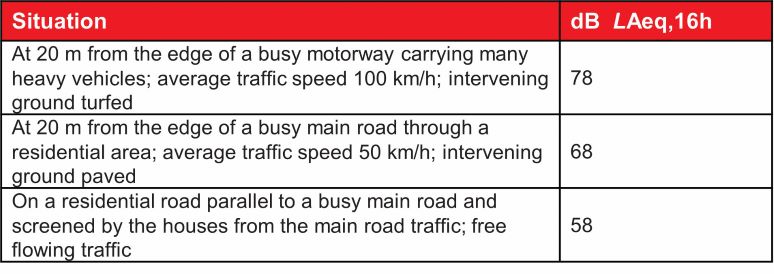
During a project’s design stages, an acoustician should conduct a detailed investigation of the expected relevant (future) noise levels at various façade points & at different heights to be able to specify the correct mitigation measure to ensure compliance with the requirements (which vary throughout the building).
A noise survey may not be possible in some scenarios, for example when construction is taking place near the plot, or when a future noise source is not yet a reality (such as a new expressway etc.). In this case, the acoustician would need to evaluate the future noise levels that are expected to occur. Typical road traffic noise levels are for example provided in the BS 8233 guidance for three common situations (Table 2), however detailed studies will be required for an accurate assessment.
This can be done with the use of acoustic software for outdoor noise modelling. Noise modelling plays a crucial role in allowing designers to accurately predict and mitigate potential noise impacts on building occupants. The use of advanced acoustic simulation software allows designers to study the noise emission of for example an industrial plant, expressways, a new local road or railway track, an airport, or even entire towns and urbanised areas.
Based on the noise assessment study, the façade system and glazing elements need to be specified for various parts of the building based on attenuation requirements in terms of Rw+Ctr or the OITC. It may further be required to specify sound insulation requirements in octave bands.
FAÇADE DESIGN TECHNIQUES FOR IMPROVING ACOUSTICS
As a next step in achieving good acoustics within a building, it is crucial to understand how different materials or elements offer noise control. A building envelope constructed of elements that are denser in nature (such as concrete or masonry) provides a better level of acoustic separation than lightweight elements. Effective sound insulation techniques, such as introducing air gaps, sound-absorbing materials, and appropriate building orientation can further help minimise the negative impacts of external noise sources. The placement of balconies in the façade design can also help mitigate the transmission of sound and reduce the impact of external noise on interior spaces.
The acoustic performance of glazing systems is greatly influenced by the type of glass, its dimensions, its density, the right order of glass panes and the cavity between them. It is expected that a standard double-glazing system (6/12/6) will offer a sound reduction of around 32 dB. This can be improved by using thicker panes and special acoustic-grade glass (laminated glass), increasing the cavity, or adding secondary glazing. A glazing system typically performs best when the inner and outer panes have different thicknesses. However, even though the introduction of airgaps may improve the overall sound insulation performance of the system, this could also lead to a reduced sound insulation performance in low frequencies (which could be a concern for certain noise sources such as road traffic, plant equipment etc.).
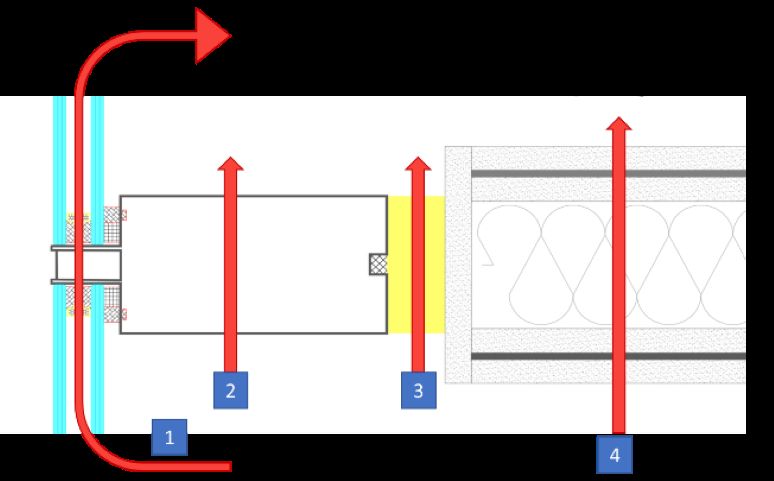
- Glazing
- Mullion
- Sealing /Junction
- Separating elements
- Continuous Mullion
Laminated glass can improve acoustical separation by allowing for resistance change in the material. By adding a thin layer of polyvinyl butyral (PVB) or ethylene-vinyl acetate between two thin layers of glass, the change in density between the glass and the lamination layer results in the reflection of some of the sound energy. In this way, the glazing system can improve its sound insulation performance.
Another potential issue with the façade is the flanking noise transmission. Typical flanking noise transmission scenarios are shown in Figure 4 and Figure 5. When designing façades, the façade framing can act as a weak point in terms of both intrusive noise and flanking noise between rooms (both horizontal and vertical noise transfer). Mullions, transoms, spandrel panels and other architectural/structural junctions are critical aspects of acoustic design. Even if high-performing glazing is used which may offer good acoustic insulation, noise can still penetrate the building interior via other flanking elements and noise can also transfer via one room to another due to flanking.
To prevent sound waves from being transmitted through a building, the acoustic consultant and the façade consultant need to address all elements and connections, particularly glazing-to-rigid interfaces and metal-to-metal interfaces. By adding acoustic insulation and gypsum layers to mullion and transom profiles as well as creating additional acoustic barriers between the frame and floor slabs, flanking noise can be reduced.
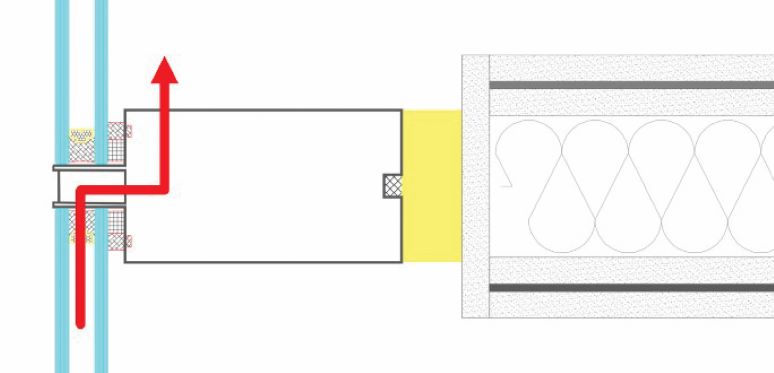
It should be noted that glass systems come with limitations and even a system with thick panes of glass and large air gaps may not achieve the requirements for highly sensitive spaces where there is a high external noise level. In such cases, a solid façade element (e.g. concrete blocks) may be the only feasible solution. Besides glass, composite panels made with aluminium or steel and insulation cores can help increase acoustic performance. However, these systems may also lead to poor isolation for low frequencies and this needs to be taken into account in the design.
CONCLUSION
As a final thought, I would like to say that, despite the visual, thermal, and fire/life safety aspects of a façade being the most discussed factors, the acoustical aspects discussed above are vital to the overall success of a project. It is important to establish and clearly define the indoor noise targets that need to be achieved as per code/ legislation, operator specifications, or project stakeholders.
Acoustics as a whole needs to be taken into consideration in the early stages of the project. A collaborative, cohesive design approach can help improve the façade acoustic comfort for the building and ensure client satisfaction.














